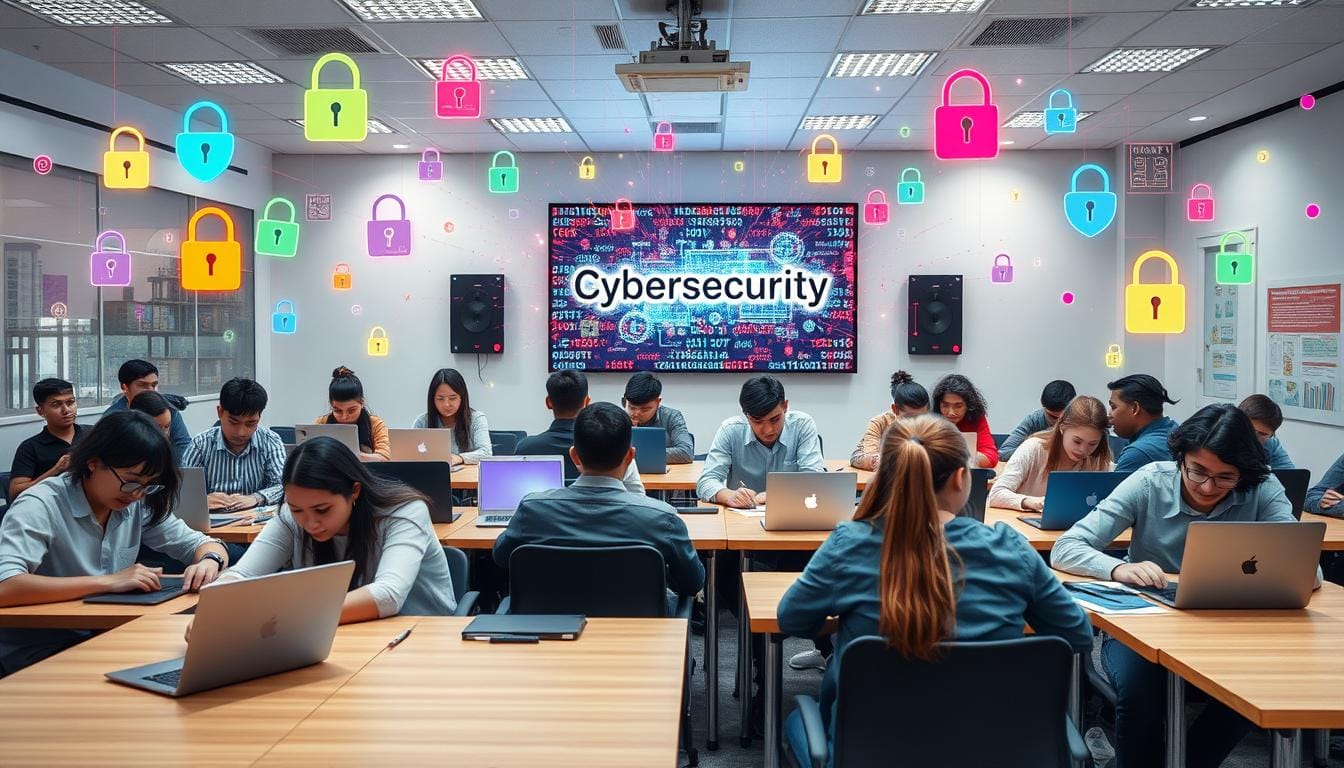Essential Cybersecurity Tips for Students
“The internet is becoming the town square for the global village of tomorrow.” – Bill Gates, Co-founder of Microsoft
Today, students rely heavily on technology for school and personal life. The internet is key for online classes, research, social media, and fun. But, it also means students need strong cybersecurity to stay safe from online dangers.

Students must know how to protect their personal info, school data, and online actions. This guide offers vital cybersecurity advice for Indian students. It helps them stay safe and enjoy the digital world’s many benefits.
Main Topics
- Understand the evolving digital threats targeting students in academic environments
- Implement robust password management practices and two-factor authentication
- Adopt safe browsing and social media habits to protect personal information
- Utilize VPNs and secure public Wi-Fi connections to safeguard data on campus networks
- Defend against malware and ransomware attacks through proactive measures
Understanding Digital Threats in Academic Environments
In today’s digital world, students face many cybersecurity threats. These threats can harm their studies and personal info. It’s key for students to know about phishing awareness, malware prevention, and identity theft precautions. They need to understand the common cyber attacks and how they can affect their school life.
Common Cyber Attacks Targeting Students
Phishing scams are a big threat in schools. Scammers try to steal sensitive info through fake emails or websites. Students are often targeted because they might be more open to these tricks. Also, malware can harm device security and privacy, posing a big risk for students.
Impact of Security Breaches on Academic Life
Cyber attacks can have serious effects on students and schools. They can lose important work, disrupt classes, and expose personal info. This can lead to identity theft and other serious problems.
Current Cybersecurity Landscape in Education
The education sector is facing more cybersecurity challenges. Schools and universities are trying to improve malware prevention and phishing awareness. But, there’s still a lot to do to keep students and academic data safe.
As the digital world changes, students must stay alert and protect themselves online. Knowing about common cyber threats helps them stay safe. This way, they can help make their school environment more secure.
Cybersecurity Tips for Students: Essential Protection Measures
Students need to focus on password management, data protection, and cybersecurity. These steps help keep your school and personal info safe from cyber threats.
Password Management Best Practices
Creating strong, unique passwords is key to protecting your online stuff. Don’t use common phrases or personal info that’s easy to guess. Use a good password manager to keep your passwords safe and different for each account.
Two-Factor Authentication Implementation
Turn on two-factor authentication (2FA) when you can. This adds an extra step, like a code sent to your phone, to log in. 2FA makes it harder for hackers to get into your accounts.
Safe Data Backup Strategies
Backing up your important files regularly is vital. Use cloud storage or an external hard drive for safe backups. This way, you can quickly get back your files if something goes wrong.

“Cybersecurity is not just an IT issue, it’s a shared responsibility. By adopting these essential protection measures, students can take an active role in safeguarding their digital lives and academic success.”
Safe Browsing and Social Media Practices
In today’s world, keeping online safety and social media privacy is key for students. Phishing is a big threat, where hackers try to get personal info from students. Always be careful with links and attachments, even if they seem safe.
On social media, students should think about what they share and their privacy settings. It’s smart to check and change these settings often. This helps keep personal info safe from hackers.
- Be wary of suspicious links or attachments, even from known sources.
- Regularly review and optimize social media privacy settings.
- Limit the personal information shared on social media platforms.
By following these online safety tips, students can stay safe online. They can enjoy a safer and more secure digital world.
“Cybersecurity is not just an IT issue, it’s a personal responsibility for everyone.”

Protecting Personal Information on Campus Networks
Students need to protect their personal info in the digital world of campus. It’s important to know about public wi-fi risks and how to keep devices safe in shared areas. This helps keep data safe.
Public Wi-Fi Safety Guidelines
Public wi-fi on campus is convenient but risky. Students should watch out for public wi-fi risks. These networks can be hacked and data stolen. Here’s how to stay safe:
- Don’t use public wi-fi for sensitive stuff like online banking or email.
- Use a VPN to encrypt your internet and protect your data.
- Be careful of who might see your screen.
VPN Usage for Students
A good VPN is key for data protection on campus. It makes your internet connection secure and private. With a VPN, students can safely use public wi-fi and keep their info safe.
Device Security in Shared Spaces
Libraries, computer labs, and other shared areas are tricky for device security. Students should take steps to protect their devices. Here’s how:
- Turn on device encryption to keep data safe.
- Don’t leave devices alone in public.
- Use privacy screens or anti-glare filters to stop shoulder-surfing.
By following these cybersecurity tips for students, they can safely use campus networks. This way, they can protect their data protection and avoid risks from public wi-fi and shared computers.
Email Security and Phishing Prevention
In today’s digital world, keeping your email safe is key to cybersecurity tips for students and online safety. Phishing attacks are a big threat. These attacks try to trick people into sharing sensitive info, which can harm students and schools.
To avoid these scams, learn to spot suspicious emails. Watch for generic greetings, urgent messages, and requests for personal info. Also, be careful with emails that have attachments or links, as they might have malware or lead to fake sites.
Keeping your email clean is also crucial. Update your email’s security, use two-factor authentication, and be careful when using public devices. If you think you’ve been phished, tell your school’s IT team right away.
By being careful and taking steps to protect yourself, you can lower the risk of phishing awareness. A bit of caution can help keep your cybersecurity tips for students and online safety strong.
Identifying Phishing Attempts
- Be wary of emails with generic greetings or urgent calls to action
- Scrutinize the sender’s email address for any discrepancies or impersonations
- Avoid clicking on suspicious links or opening attachments from unknown sources
Maintaining Email Hygiene
- Regularly update your email account’s security settings
- Enable two-factor authentication to add an extra layer of protection
- Avoid accessing your email on public or shared devices whenever possible
- Report any suspected phishing attempts to your institution’s IT support team
| Phishing Attempt Characteristics | Legitimate Email Characteristics |
|---|---|
| Urgent or threatening tone | Calm and informative tone |
| Requests for personal/financial information | Does not request sensitive information |
| Suspicious email address or domain | Recognizable and trusted email address |
| Embedded links or attachments | Minimizes the use of links and attachments |
Protecting Against Malware and Ransomware
In today’s digital world, malware and ransomware are big threats for students. These harmful programs can get into your devices and steal your personal info and school work. It’s key to use malware prevention steps and watch out for new cybersecurity threats.
Keeping your software and operating systems current is a must for data protection. Updates often fix security holes, making it tough for malware to get in. Also, using good antivirus software can catch and remove any bad code.
Ransomware is a nasty malware that locks your files and asks for money to unlock them. To avoid it, be careful when downloading files or apps, even if they seem safe. Make sure the source is real and safe to prevent ransomware.
| Malware Type | Description | Example |
|---|---|---|
| Viruses | Malware that can replicate and spread to other files or systems | WannaCry ransomware |
| Trojans | Malware disguised as legitimate software to gain access to your system | Zeus banking Trojan |
| Spyware | Malware that collects and transmits your personal information without your knowledge | KeyLogger |
By knowing the latest cybersecurity tips for students and using strong protection, you can lower the risks of malware and ransomware. This keeps your school work and personal info safe.
“Cybersecurity is not an option; it’s a necessity in today’s digital landscape. Protecting your data should be a top priority for all students.”
Conclusion
As we wrap up our look at cybersecurity tips for students, it’s clear that keeping safe online is a big job. The digital world keeps changing, but the basics of staying safe are still key. Students in India need to be careful, follow the best practices, and help build a safe digital community.
Students can protect themselves by using strong passwords and two-factor authentication. It’s also important to know how to avoid cyber attacks like phishing and malware. These attacks can harm your school work and personal life a lot.
Cyberbullying is another big issue online. Students can help make the internet safer by being kind and responsible online. Remember, the internet is a place we all share. What we do online affects everyone around us.
FAQ
What are the most common cyber threats targeting students?
Common threats include phishing, malware, identity theft, and data breaches. Students are at risk because they use technology a lot for school and personal stuff.
How can students protect their personal information on campus networks?
Students can use a VPN, be careful with public Wi-Fi, and lock their devices in places like libraries. This helps keep their info safe.
What are the best practices for password management?
Good password habits include using a manager, making strong, unique passwords, and enabling two-factor auth. Also, update your passwords often.
How can students stay safe on social media?
To stay safe, students should not share too much personal info, adjust privacy settings, and watch out for phishing scams. These scams can look like messages or posts from friends.
What should students do to protect against malware and ransomware?
To avoid malware and ransomware, keep your software and OS updated. Use good antivirus software and be careful when downloading files or apps.
How can students identify and prevent phishing attempts?
To spot phishing, check email addresses and be cautious of requests for personal info. Always verify links and attachments before clicking on them.
What are the key steps for safe data backup?
For safe backups, regularly save important files and use both local and cloud storage. Make sure to check your backups to ensure you can restore your data if needed.















